2材料科学基础英文版课件弒资
合集下载
2材料科学基础英文版课件_(13)

– Time-dependent process, the rate of mass transfer is expressed as a diffusion flux (J)
JM At
Mass transferred through a crosssectional area
Diffusion time
Mathematics of Diffusion (5)
The diffusion equation is represented by
C (DC)
t
x
x
Fick’s second law C is a function of x and t
If D is independent of the composition, the above equation changes to
J
Mathematics of Diffusion (3)
For steady-state diffusion, the diffusion flux is proportional to the concentration gradient
The mathematics of steady-state diffusion in one dimension is given by
For t>0, Cx=Cs at x=0 Cx=Co at x=
Area across which the diffusion occurs
In differential form
J 1 dM A dt
J = Mass transferred through a unit area per unit time (g/m2 s))
JM At
Mass transferred through a crosssectional area
Diffusion time
Mathematics of Diffusion (5)
The diffusion equation is represented by
C (DC)
t
x
x
Fick’s second law C is a function of x and t
If D is independent of the composition, the above equation changes to
J
Mathematics of Diffusion (3)
For steady-state diffusion, the diffusion flux is proportional to the concentration gradient
The mathematics of steady-state diffusion in one dimension is given by
For t>0, Cx=Cs at x=0 Cx=Co at x=
Area across which the diffusion occurs
In differential form
J 1 dM A dt
J = Mass transferred through a unit area per unit time (g/m2 s))
材料科学基础英文版课件
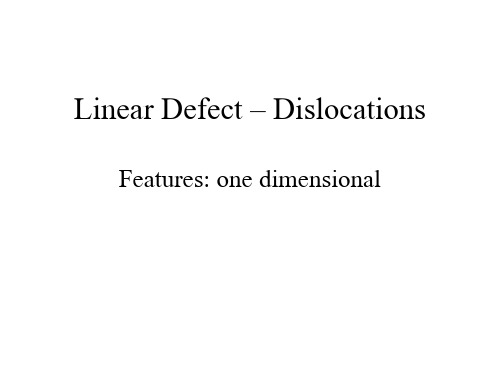
Classification of grain boundary segregation
• Equilibrium segregation
– Thermodynamic process – Driving force: solute-boundary binding energy (the
difference in energy caused by a solute atom between staying in the grain interior and on the grain boundary
– One dislocation just has one b
– For metals, b normally points in a close-packed crystal direction and its magnitude is the interatomic spacing because the slip direction is normally in the close-packed direction
• To reduce the surface energy, the materials tend to minimize the total surface area
Grain Boundaries
In polycrystalline materials, a grain boundary is the boundary between two adjacent grains which have different orientations
Linear Defect – Dislocations
Features: one dimensional
最新2材料科学基础英文版课件_(10)
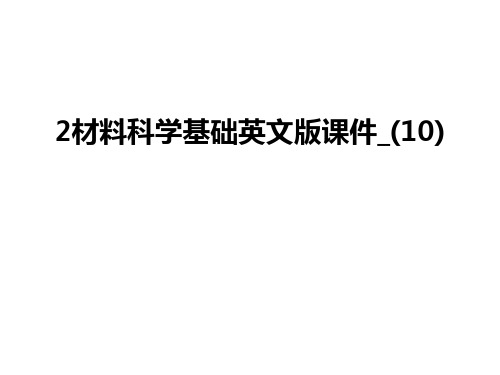
External Surfaces
• Surface atoms are not bonded to the nearest neighbors above the surface, leading to a higher energy state, i.e., a surface energy
• To be stable, materials need to reduce the surface energy.
Edge dislocation
Screw dislocation
Mixed dislocation
• Effects of dislocations on the properties of materials
–ormation of materials
Tilt boundary
Twist boundary
Use to represent the extent of CSL e.g., 3, 15, etc.
CSL boundary (coincidence site lattice boundary) Special boundary
Grain boundary segregation
• Observation of dislocations
Dark lines - dislocations
Plane Defects
Features: two dimensional
Outline
• External surfaces • Grain boundaries • Twin boundaries • Stacking faults • Phase boundaries
– Dislocation strengthening is one of the major strengthening mechanisms for metallic materials
材料科学基础(英)2
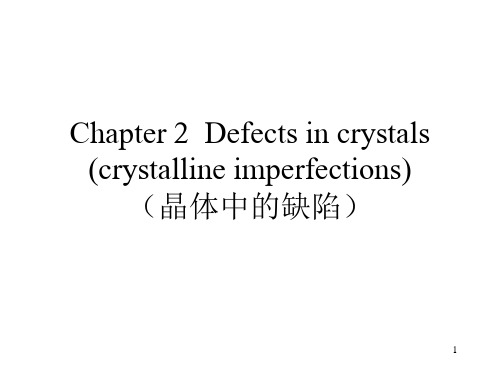
点缺陷与线缺陷和面缺陷的一个主要区别在于点缺陷是 一种热力学稳定的缺陷,在晶体中,点缺陷始终处于不 断产生和消失的过程中,最终达到一个稳定的平衡值, 此时晶体中点缺陷数目不变,可以通过统计热力学的方 法进行计算。 两种点缺陷中,空位具有比较小的畸变能。 10
At equilibrium, the fraction of lattice that is vacant at a given temperature (T) is given approximately by the equation: n where n is the number of vacant sites in N sites and Es is the energy required to move an atom from the interior of a crystal to its surface. k is Boltzmann’s constant and equal to 1.380*10-23JK-1. Additional vacancies in metals can be introduced by plastic deformation, rapid cooling, and bombardment with energetic particles such as neutrons.
15
C04CATER.MOV
16
• 1934 年,Taylor 、Orowan 和Polanyi 几乎同时分 别独立地提出了位错模型,认为晶体存在有一种 线缺陷—刃型位错,它在切应力下容易滑移,并 可引起范性形变。其中以Taylor 的工作最为深 入,他把位错与晶体塑性时的滑移过程联系起来 。滑移时,晶体的上半部相对于下半部不是同时 作整体刚性的移动,而是通过位错在切应力作用 下于晶体中逐步地移动来进行。当位错由晶体 的一端移到另一端时,只需其邻近原子作很小距 离的弹性偏离就可能实现,而晶体中其它区域的 原子仍处于正常位置,因而滑移时所需的切应力 大为减少。
At equilibrium, the fraction of lattice that is vacant at a given temperature (T) is given approximately by the equation: n where n is the number of vacant sites in N sites and Es is the energy required to move an atom from the interior of a crystal to its surface. k is Boltzmann’s constant and equal to 1.380*10-23JK-1. Additional vacancies in metals can be introduced by plastic deformation, rapid cooling, and bombardment with energetic particles such as neutrons.
15
C04CATER.MOV
16
• 1934 年,Taylor 、Orowan 和Polanyi 几乎同时分 别独立地提出了位错模型,认为晶体存在有一种 线缺陷—刃型位错,它在切应力下容易滑移,并 可引起范性形变。其中以Taylor 的工作最为深 入,他把位错与晶体塑性时的滑移过程联系起来 。滑移时,晶体的上半部相对于下半部不是同时 作整体刚性的移动,而是通过位错在切应力作用 下于晶体中逐步地移动来进行。当位错由晶体 的一端移到另一端时,只需其邻近原子作很小距 离的弹性偏离就可能实现,而晶体中其它区域的 原子仍处于正常位置,因而滑移时所需的切应力 大为减少。
2材料科学基础英文版课件_

30 P
25 P
20
P
15
10
Mo
Mo
Mo
5
0
480
520
560
Ageing temperature (oC)
Equilibrium boundary concentrations at different temperatures
2019/10/16
40
P
P
P
30
20
Mo
Mo
Mo
10
0
480
520
Preface (3)
GS
Thermally induced NEGS
Stress induced NEGS
2019/10/16
EGS
பைடு நூலகம்
NEGS
Irradiation induced NEGS
……
NEGS induced by high
temperature deformation
Preface (4)
2.25Cr1Mo钢中磷的平衡及应力引 起的非平衡晶界偏聚
Equilibrium and Stress-induced NonEquilibrium Grain Boundary Segregations
of Phosphorus in a 2.25Cr1Mo Steel
Song Shenhua
2019/10/16
Temperature
Experiment (3)
(Austenization) (Normalization)
980℃×30min 920℃×50min
(Termper)
650℃×2h
(Ageing)
材料科学基础双语课件
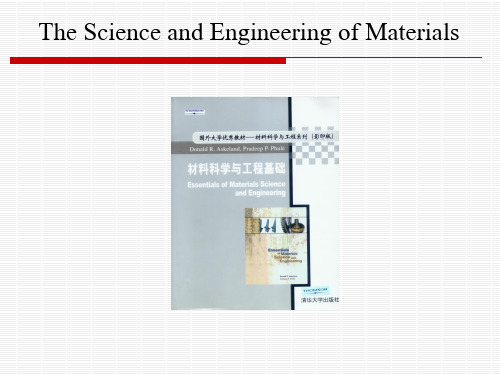
control the material properties (for example by altering the
grain structure, or the presence of defects in the atom
packing) or to fabricate the material into the desired shape.
extra material, joining parts (e.g., by soldering or welding),
forming (forging, rolling, bending, etc.), or compacting particles which are then fused together (sintering, used for
gases (and most engineering materials are used in solid
form).
1.1 What is Materials Science and Engineering?
It may seem abstract and remote from real engineering to
The Science and Engineering of Materials
Aim
English atmosphere: speaking, reading, writing and lisห้องสมุดไป่ตู้ening; Specialty vocabulary; Specialty knowledge;
form. As this mixture solidifies, different structures form as a function of temperature. The phase diagrams that provide
grain structure, or the presence of defects in the atom
packing) or to fabricate the material into the desired shape.
extra material, joining parts (e.g., by soldering or welding),
forming (forging, rolling, bending, etc.), or compacting particles which are then fused together (sintering, used for
gases (and most engineering materials are used in solid
form).
1.1 What is Materials Science and Engineering?
It may seem abstract and remote from real engineering to
The Science and Engineering of Materials
Aim
English atmosphere: speaking, reading, writing and lisห้องสมุดไป่ตู้ening; Specialty vocabulary; Specialty knowledge;
form. As this mixture solidifies, different structures form as a function of temperature. The phase diagrams that provide
2材料科学基础英文版课件_(12)
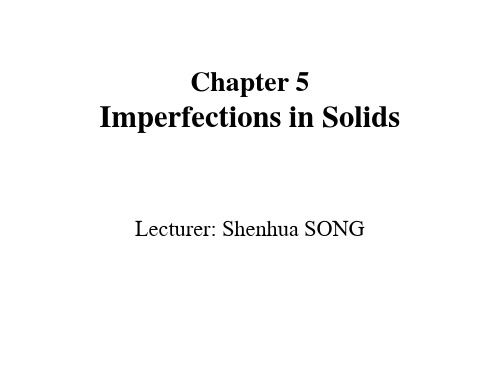
• Deformation-induced nonequilibrium vacancies
Point Defects – Point Defects in Metals (4)
The molar free energy of the crystal containing Xv mole of vacancies:
பைடு நூலகம்• There is always some level of impurity or foreign atoms in a metal, leading to the formation of an alloy
• Alloys – solid solutions and intermetallics • Concept: solvent – the matrix or host; solute
• Thermal equilibrium vacancies and interstitials
• Quenching-induced nonequilibrium vacancies and interstitials
• Irradiation-induced nonequilibrium vacancies and interrstitials
Point Defects – Point Defects in Metals (1)
1. Vacancies and Interstitials (self-interstitials)
Frenkel pair: vacancy + interstitial
Schottky defect: moving an atom to the surface produces a vacancy
Point Defects – Point Defects in Metals (4)
The molar free energy of the crystal containing Xv mole of vacancies:
பைடு நூலகம்• There is always some level of impurity or foreign atoms in a metal, leading to the formation of an alloy
• Alloys – solid solutions and intermetallics • Concept: solvent – the matrix or host; solute
• Thermal equilibrium vacancies and interstitials
• Quenching-induced nonequilibrium vacancies and interstitials
• Irradiation-induced nonequilibrium vacancies and interrstitials
Point Defects – Point Defects in Metals (1)
1. Vacancies and Interstitials (self-interstitials)
Frenkel pair: vacancy + interstitial
Schottky defect: moving an atom to the surface produces a vacancy
材料科学基础英文版课件(PDF)
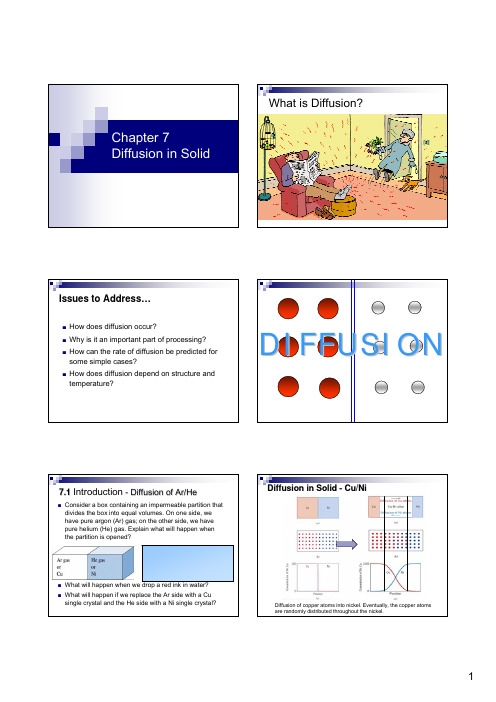
Law • Steady State: the concentration profile doesn't
change with time.
Steady State:
J x(left)
J x(right) J x(left) = J x(right)
x
Concentration, C, in the box doesn’t change w/time.
Non Steady State Diffusion
• Concentration profile,
dx
C(x), changes with time. J (left)
J (right)
• To conserve matter:
J (right)
− J (left)
=
dC −
dx
dt
dJ = − dC
ΔJ y
=
− ∂J y ∂y
dxdydzδt
ΔJ z
= − ∂J z ∂z
dxdydzδt
对整个元体积:
−
⎜⎜⎝⎛
∂J x ∂x
+
∂J y ∂y
+
∂J z ∂z
⎟⎟⎠⎞dxdydzδt
若 δt 时间内粒子浓度变化δc ,则在dxdydz
元体积中粒子变化为
δcdxdydz
∴ ∂c ∂t
=
−⎜⎜⎝⎛
∂J x ∂x
Fick’s Second Law
δt 时间内沿x方向扩散
元体积dxdydz
流入的粒子数: J x dydzδt
流出的粒子数:
(J x
+
∂J x ∂x
dx)dydzδt
2材料科学基础英文版课件_(16)
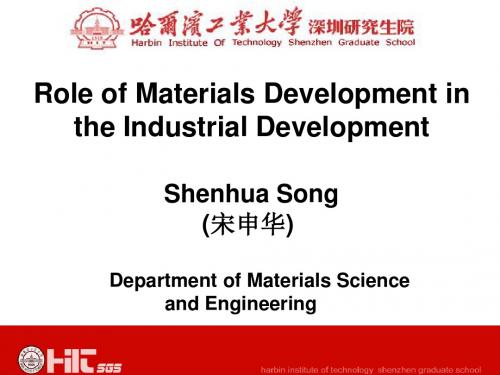
• Effect of materials development on the aeronautical industry
Materials are fundamentals of human being civilization
Stone Age ~5000 years ago
Bronze Age ~2500 years ago
• Steam engine ship • Steam engine train • Steam blast furnace in the metallurgical industry) • Steam-related machines in the coal mine industry • Steam hammer, steam lathe, etc. in mechanical industry
Shenhua Song (宋申华)
Department of Materials Science and Engineering
Outline
• Introduction • Effect of materials development on the automotive industry • Effect of materials development on the power generation industry
Possible body applications
Instrument panel (Fiat Stilo)
Instrument panel (BMW Mini)
Mg sheet applications
Mg bonnet (VW 3 l Lupo)
Mg bonnet after crash test (ODB - 64 km/h)
2材料科学基础英文版12

Formation – leading to an increase of internal energy – free energy increase (G = H - TS, H=U+PV, U - H - G ) Formation – leading to an increase of entropy (randomness) –free energy decrease At a given temperature, there must be a concentration of point defects at which the free energy of the system has a minimum value.
• Deformation-induced nonequilibrium vacancies
Point Defects – Point Defects in Metals (2)
Why there is a thermal equilibrium concentration for vacancies or interstitials (self-interstitials)
• Volume defects
Dislocations External surfaces Grain boundaries Twin boundaries Stacking faults Phase boundaries
Pores, cracks, inclusions, and second pPoint Defects in Metals (5)
Or
(G = H - T S)
is in units of the mole fraction and can also be represented by = Nv/N where Nv is the number of vacancies at
• Deformation-induced nonequilibrium vacancies
Point Defects – Point Defects in Metals (2)
Why there is a thermal equilibrium concentration for vacancies or interstitials (self-interstitials)
• Volume defects
Dislocations External surfaces Grain boundaries Twin boundaries Stacking faults Phase boundaries
Pores, cracks, inclusions, and second pPoint Defects in Metals (5)
Or
(G = H - T S)
is in units of the mole fraction and can also be represented by = Nv/N where Nv is the number of vacancies at
2材料科学基础英文版课件_
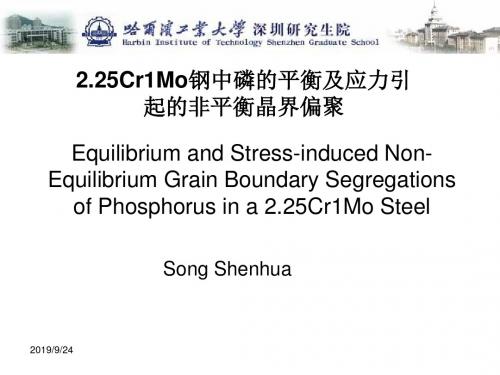
• Stress-induced non-equilibrium grain boundary
segregation – Introduction, experiment, results and discussion,
summary
• Conclusions
2019/9/24
Outline (1)
Ingot
Block 1
Sample processing and pretreatment
Pretreated samples
Aging at different temperatures for different times and quenching
Machining
2019/9/24
Experiment (2)
Applied stress
2019/9/24
2.25Cr1Mo steel
Outline (1)
• Equilibrium grain boundary segregation
– Segregation of phosphorus and molybdenum
• Introduction, experiment, results and discussion, summary
520℃
2019/9/24
Time
Heat treatment procedure
Experiment (4)
Auger electron spectrometer
2019/9/24
Auger specimen
Experiment (5)
2019/9/24
AES scanning position
– Effect of phosphorus grain boundary segregation on intergranular fracture
segregation – Introduction, experiment, results and discussion,
summary
• Conclusions
2019/9/24
Outline (1)
Ingot
Block 1
Sample processing and pretreatment
Pretreated samples
Aging at different temperatures for different times and quenching
Machining
2019/9/24
Experiment (2)
Applied stress
2019/9/24
2.25Cr1Mo steel
Outline (1)
• Equilibrium grain boundary segregation
– Segregation of phosphorus and molybdenum
• Introduction, experiment, results and discussion, summary
520℃
2019/9/24
Time
Heat treatment procedure
Experiment (4)
Auger electron spectrometer
2019/9/24
Auger specimen
Experiment (5)
2019/9/24
AES scanning position
– Effect of phosphorus grain boundary segregation on intergranular fracture
